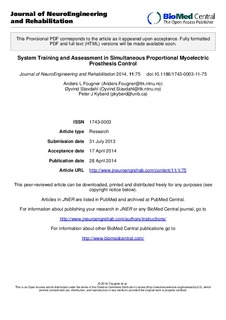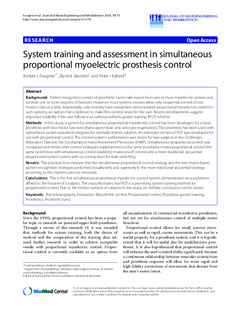| dc.contributor.author | Fougner, Anders Lyngvi | |
| dc.contributor.author | Stavdahl, Øyvind | |
| dc.contributor.author | Kyberd, Peter Joseph | |
| dc.date.accessioned | 2014-06-28T12:31:00Z | |
| dc.date.accessioned | 2016-06-10T11:18:14Z | |
| dc.date.available | 2014-06-28T12:31:00Z | |
| dc.date.available | 2016-06-10T11:18:14Z | |
| dc.date.issued | 2014 | |
| dc.identifier.citation | Journal of NeuroEngineering and Rehabilitation 2014, 11(75):1-13 | nb_NO |
| dc.identifier.issn | 1743-0003 | |
| dc.identifier.uri | http://hdl.handle.net/11250/2392223 | |
| dc.description.abstract | Background
Pattern recognition control of prosthetic hands take inputs from one or more myoelectric sensors and controls one or more degrees of freedom. However, most systems created allow only sequential control of one motion class at a time. Additionally, only recently have researchers demonstrated proportional myoelectric control in such systems, an option that is believed to make fine control easier for the user. Recent developments suggest improved reliability if the user follows a so-called prosthesis guided training (PGT) scheme.
Methods
In this study, a system for simultaneous proportional myoelectric control has been developed for a hand prosthesis with two motor functions (hand open/close, and wrist pro-/supination). The prosthesis has been used with a prosthesis socket equivalent designed for normally-limbed subjects. An extended version of PGT was developed for use with proportional control. The control system’s performance was tested for two subjects in the Clothespin Relocation Task and the Southampton Hand Assessment Procedure (SHAP). Simultaneous proportional control was compared with three other control strategies implemented on the same prosthesis: mutex proportional control (the same system but with simultaneous control disabled), mutex on-off control, and a more traditional, sequential proportional control system with co-contractions for state switching.
Results
The practical tests indicate that the simultaneous proportional control strategy and the two mutex-based pattern recognition strategies performed equally well, and superiorly to the more traditional sequential strategy according to the chosen outcome measures.
Conclusions
This is the first simultaneous proportional myoelectric control system demonstrated on a prosthesis affixed to the forearm of a subject. The study illustrates that PGT is a promising system training method for proportional control. Due to the limited number of subjects in this study, no definite conclusions can be drawn. | nb_NO |
| dc.language.iso | eng | nb_NO |
| dc.publisher | BioMed Central | nb_NO |
| dc.relation.uri | http://www.jneuroengrehab.com/content/11/1/75/ | |
| dc.rights.uri | http://creativecommons.org/licenses/by/2.0/ | |
| dc.title | System Training and Assessment in Simultaneous Proportional Myoelectric Prosthesis Control | nb_NO |
| dc.type | Journal article | nb_NO |
| dc.type | Peer reviewed | nb_NO |
| dc.date.updated | 2014-06-28T12:31:00Z | |
| dc.subject.nsi | VDP::Teknologi: 500::Medisinsk teknologi: 620 | nb_NO |
| dc.subject.nsi | VDP::Technology: 500::Medical technology: 620 | nb_NO |
| dc.source.volume | 11 | nb_NO |
| dc.source.journal | Journal of NeuroEngineering and Rehabilitation | nb_NO |
| dc.source.issue | 1 | nb_NO |
| dc.identifier.doi | 10.1186/1743-0003-11-75 | |
| dc.identifier.cristin | 1129244 | |
| dc.subject.keyword | Kybernetikk / Cybernetics | |
| dc.subject.keyword | Proteser og implantater / Prostheses and Implants | |
| dc.subject.keyword | Protesestyring / Prosthesis control | |
| dc.subject.keyword | Reguleringsteknikk / Control technology | |
| dc.description.localcode | © 2014 Fougner et al.; licensee BioMed Central Ltd. This is an Open Access article distributed under the terms of the Creative Commons Attribution License (http://creativecommons.org/licenses/by/2.0), which permits unrestricted use, distribution, and reproduction in any medium, provided the original work is properly credited. | nb_NO |


